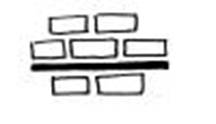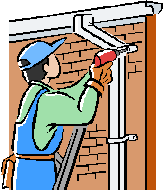Damp Proof Courses
What are these for?
1stAssociated.com can provide help and advice with regard to buying a property, residential building reports, commercial building reports, buying at auction, dilapidations, schedules of condition, specific defects reports of problems in a property, and much more.
We are independent surveyors as we are not affiliated to any bank or building society and can offer you impartial advice. Our survey repots are in an easy to undertand format, with photos of the property and sketches.
Please Free phone us on 0800 298 5424 and surveyor will call you back.
Free phone 0800 298 5424
Which damp proof courses were first added to properties?
 At first it seems relatively easy to answer, with many articles, books and websites on dampness quoting the 1875 Public Health Act. However, as Jeff Howell points out in his excellent book The Rising Damp Myth, very few people have actually looked at the Public Health Act 1875 and in his book he advises that it has only been looked at three times since the World War II (and we weren't one of these people).
At first it seems relatively easy to answer, with many articles, books and websites on dampness quoting the 1875 Public Health Act. However, as Jeff Howell points out in his excellent book The Rising Damp Myth, very few people have actually looked at the Public Health Act 1875 and in his book he advises that it has only been looked at three times since the World War II (and we weren't one of these people).
So, where do damp proof courses come from?
 Jeff Howell interestingly advises that he was unable to find anything about damp proof courses (also known as DPCs) after two days of studying the Act, which he concluded was clearly designed to improve sewerage and drainage in buildings, as remember outbreaks of cholera and dysentery, were still common in London, and we assume, the major cities and towns. Jeff Howell then goes onto advise that he eventually found a mention of a requirement for a damp proof course beneath the level of the lowest timbers in a local government board's model by-laws of 1877, remembering that timber was a material that was used years ago.
Jeff Howell interestingly advises that he was unable to find anything about damp proof courses (also known as DPCs) after two days of studying the Act, which he concluded was clearly designed to improve sewerage and drainage in buildings, as remember outbreaks of cholera and dysentery, were still common in London, and we assume, the major cities and towns. Jeff Howell then goes onto advise that he eventually found a mention of a requirement for a damp proof course beneath the level of the lowest timbers in a local government board's model by-laws of 1877, remembering that timber was a material that was used years ago.
Why do we have damp proof courses?
 This is a fascinating question. We have heard, and read, from SPAB; The Society of Protection of Ancient Buildings and various books that we have read and presentations that we have been to, that say the damp proof course was not to stop damp coming into the properties in the form of rising ground water, but to stop sewerage getting into the properties.
This is a fascinating question. We have heard, and read, from SPAB; The Society of Protection of Ancient Buildings and various books that we have read and presentations that we have been to, that say the damp proof course was not to stop damp coming into the properties in the form of rising ground water, but to stop sewerage getting into the properties.
Let us travel back in time
 This is because the common man at the time was literally throwing the sewerage into the streets, from what we understand, with an open gully running down the centre of the street, finally getting into the sewers. This leads to interesting speculation on two accounts:
This is because the common man at the time was literally throwing the sewerage into the streets, from what we understand, with an open gully running down the centre of the street, finally getting into the sewers. This leads to interesting speculation on two accounts:
• The cast iron boot scrapers that you see in walls of some older properties weren't just to scrape the mud off your shoes!
• The damp proof course was an attempt to prevent walls, remembering in those days that many were constructed from a timber frame, and floor timbers from being saturated with the sewerage that was being brought in from the adjoining streets.
Sanitary conditions you just wouldn't recognise
 It seems almost incomprehensible to us now where most homes have the luxury of hot and cold water (in the UK ). We also feel safe to say that the majority of us in the UK have our bathrooms inside and many of us have an en-suite and indeed, we have been looking at modern properties where each bedroom seems to have an en-suite. It was only a few generations ago we were throwing sewerage into the street, not to mention the horse transport system adding to it. It really was only the rich who had anything resembling the sort of sanitary arrangements we have today.
It seems almost incomprehensible to us now where most homes have the luxury of hot and cold water (in the UK ). We also feel safe to say that the majority of us in the UK have our bathrooms inside and many of us have an en-suite and indeed, we have been looking at modern properties where each bedroom seems to have an en-suite. It was only a few generations ago we were throwing sewerage into the street, not to mention the horse transport system adding to it. It really was only the rich who had anything resembling the sort of sanitary arrangements we have today.
What Wikipedia says
 We will offer you an extract from Wikipedia, which states, even as recently as the late 19th Century, sewerage systems in parts of highly industrialised UK were so inadequate that waterborne diseases, such as cholera and typhoid, were still common. In Merthyr Tydfil, a large town in South Wales , some houses discharged their sewerage to individual cesspits, which persistently overflowed, causing the pavements to be awash with foul sewerage. It also talks about waste sewerage simply running down the streets with stepping stones to keep the pedestrians out of the muck; which is quite a picture!
We will offer you an extract from Wikipedia, which states, even as recently as the late 19th Century, sewerage systems in parts of highly industrialised UK were so inadequate that waterborne diseases, such as cholera and typhoid, were still common. In Merthyr Tydfil, a large town in South Wales , some houses discharged their sewerage to individual cesspits, which persistently overflowed, causing the pavements to be awash with foul sewerage. It also talks about waste sewerage simply running down the streets with stepping stones to keep the pedestrians out of the muck; which is quite a picture!
The Great Stink of London
Between 1853 and 1854 more than 10,000 Londoners were killed by Cholera. In the summer of 1858 the Great Stink of London overwhelmed all those that were near the Thames , which was effectively a large septic tank of sewerage. However, by 1866 most of London had a collective sewerage network, devised by Joseph Bazalgette from Enfield , London . Whilst his work was concentrated in London he also gave advice to other British towns and cities and further afield, such as Budapest. Bazalgette refers to the Thames as an open sewer, which is probably a better description than a septic tank, and they constructed 83 miles of underground brick main sewers and 1,100 miles of street sewers, to intercept the raw sewerage. Unfortunately, the system did little more than divert the outflows downstream, where the sewerage was dumped untreated. It took until the 1870's to complete. Bazalgette was knighted in 1875 and you visit a monument dedicated to him on the Victoria Embankment, as well as a blue plaque on the house he lived in at St John's Wood.
 Finally, we have often known surveyors secretly wonder why engineers, when they get to a safe result then double it, and then double it again. However, in the case of the London drainage system it is fortunate that Joseph Bazalgette did this, as otherwise it is said that our sewerage system would have been full by the 1960's.
Finally, we have often known surveyors secretly wonder why engineers, when they get to a safe result then double it, and then double it again. However, in the case of the London drainage system it is fortunate that Joseph Bazalgette did this, as otherwise it is said that our sewerage system would have been full by the 1960's.
So what sort of damp proof courses did we have in years gone by?
 In our experience, the majority of damp proof courses that we actually see are slate damp proof courses in older properties, with occasional asphalt damp proof courses. We also advise that lead was sometimes used. A bed of slate would be added to a property as it was built, a few courses of brick above the ground would stop anything (and odds on it was sewerage) from rising within the wall. We are sure you can see how this was a major improvement and certainly dampness wasn't on the minds of the people that originally suggested damp proof courses were added.
In our experience, the majority of damp proof courses that we actually see are slate damp proof courses in older properties, with occasional asphalt damp proof courses. We also advise that lead was sometimes used. A bed of slate would be added to a property as it was built, a few courses of brick above the ground would stop anything (and odds on it was sewerage) from rising within the wall. We are sure you can see how this was a major improvement and certainly dampness wasn't on the minds of the people that originally suggested damp proof courses were added.
Whilst we are talking about adding DPC's we would also refer you to our article Damp proof specialists, talk to us first on inserting damp proof courses by specialist contractors, BWPDA approved.
Types of damp proof course
Slate, asphalt and lead
As mentioned earlier, we often see the edge of slate when we are carrying out surveys, particularly in Victorian properties, with asphalt being seen in more modern properties of the 1930's. It has to be said that we haven't really seen lead damp proof courses, although we can imagine how lead was used, as it was such a commonly used material in years gone by, being used predominantly for plumbing and flashings.
In our time in the building industry plastic damp proof courses have been used, which has the trade name of hiload, has been used in various widths with a blockwork inner face and brickwork outer face.
Do damp proof courses break and need repairing?
 In our experience, we have never seen a damp proof course break (fail is the common term that is used in the building industry). The closest that we have seen is where there has been considerable movement on a property and the walls have slipped on the damp proof course. However, it can be argued that they do degrade over time, particularly with the more modern damp proof courses, although we can't see a slate damp proof course degrading.
In our experience, we have never seen a damp proof course break (fail is the common term that is used in the building industry). The closest that we have seen is where there has been considerable movement on a property and the walls have slipped on the damp proof course. However, it can be argued that they do degrade over time, particularly with the more modern damp proof courses, although we can't see a slate damp proof course degrading.
Walls slipping on the damp proof course
 If you can imagine the walls built of brick or stone bonded together with a lime or cement mortar. If into this you then add a damp proof course, which is a different material with different characteristics, should there be any movement then one of the weak areas, along with the windows and door openings, would be the damp proof course.
If you can imagine the walls built of brick or stone bonded together with a lime or cement mortar. If into this you then add a damp proof course, which is a different material with different characteristics, should there be any movement then one of the weak areas, along with the windows and door openings, would be the damp proof course.
We have seen, on a few occasions, where the bricks have slipped (by this we mean moved) on the damp proof course and you then get a slight overhang of the brick, or we assume stones, although we have only actually seen this on bricks.
Do damp proof courses work and are they needed?
This is a question that we cannot answer. From reading Jeff Howell's book The Rising Damp Myth it would seem very difficult for walls (it was brick walls that he did his experiments on) to draw dampness up into the property, particularly if you consider that modern wall construction is cavity wall, where the outer layer of brickwork is meant to get wet, the inside layer sometimes getting damp but then drying off. It is only when this cavity is bridged, by either it being filled with mortar or mortar being on the wall ties, that dampness can get transferred into the inside wall.
The Jury is still out
 We would say that the Jury is still out with regard to whether rising damp exists. We certainly think that the move for surveyors not to blindly recommend damp proofing specialist companies that insert damp proof courses to older properties doesn't gather momentum, particularly on Listed buildings. We personally, on one property, spent many hours talking to a mortgage company surveyor and then the mortgage company about how they had wrongly diagnosed rising damp when it was higher external ground level and leaking gutters; the first requiring a French gully, the latter requiring the gutters to be repaired.
We would say that the Jury is still out with regard to whether rising damp exists. We certainly think that the move for surveyors not to blindly recommend damp proofing specialist companies that insert damp proof courses to older properties doesn't gather momentum, particularly on Listed buildings. We personally, on one property, spent many hours talking to a mortgage company surveyor and then the mortgage company about how they had wrongly diagnosed rising damp when it was higher external ground level and leaking gutters; the first requiring a French gully, the latter requiring the gutters to be repaired.
You may also be interested in the following articles on Dampness:
Condensation
Resolving Dampness in your Basement
Dampness in Buildings - Basics Article
Dampness in Buildings - Technical Article
Dampness Defects Report
Dampness Problems
Condensation Problems
Damp Walls
Shared Freehold and Problems with Damp
Rising Damp and Independent Reports
Further articles on Damp
Please see our section on:
Specific Defects Reports
If you do want an independent expert opinion from a surveyor with regard to dampness or anything else, or we can look at the property as a whole in the form of structural surveys, building surveys, structural reports, engineers reports, specific defects reports, such as advising you on dampness, cracks in your property, woodworm, wet rot and dry rot. For a friendly chat call 0800 298 5424 and we will even explain the difference between a full building survey and a full structural survey!
If you have a commercial property, be it leasehold or freehold, then you may wish to look at our Dilapidations Website at www.DilapsHelp.com and for Disputes go to our Disputes Help site www.DisputesHelp.com .
We hope you found the article of use and if you have any experiences that you feel should be added to this article that would benefit others, or you feel that some of the information that we have put is wrong then please do not hesitate to contact us (we are only human).
The contents of the website are for general information only and is not intended to be relied upon for specific or general decisions. Appropriate independent professional advice should be paid for before making such a decision.
All rights are reserved the contents of the website are not to be reproduced or transmitted in any form in whole or part without the express written permission of www.1stAssociated.co.uk.
If you require any information about Dampness in Properties please telephone us for help and advice0800 298 5424

